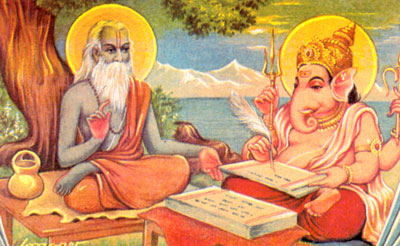The development of different Sanskrit literary texts shows that dramatic literature and poetry had parallel narrative structures and themes from Mahabharata. The first section states that Gaṇesha wrote while Vyasa gave the dictation. Vaishampayana, a disciple of Vyasa, recites his Guru’s composition to Janamejaya, great-grandson of Arjuna, in Takshashila at a ritual ‘Sarpasattra’, aimed at annihilating all snakes by drawing them into the fire [as the revenge of the killing of his father Parikshit by a snake]. When the ritual is stopped by the snake Astika, the narration of the epic happens in private. Ugrasrava, a bard, listened to Vaishampayana in Takshashila and on reaching the Naimisha forest, he came upon some Brahmins doing a Vedic ritual, led by Shaunaka Bhargava to whom he recounts the epic. There are hundreds of epics within the epic of Mahabharata. Some have become immortalized just like the main epic through the medium of folklore, poetry, drama and dance, while there are many that have hardly been noticed or remotely thought of with aesthetic purpose. In addition to the conflicts, Mahabharata not only includes philosophical texts, major devotional hymns and Bhagavad Gita but also offers some wonderful stories with episodical narratives. Folk tales like Lomasha and Palita [cat and mouse] the wicked fowler and compassionate pigeons offer advice on conduct and practical life. Good governance, features of capable statesmen, leaders, soldiers, merchants, womenfolk, families and in fact every walk of life is covered. Above all, the last annexure of Bharata Savitri summarizes the goal of life itself as dharma or righteousness.
There are few episodes like that of Ekalavya-Dronacharya, the Khandava forest fire or even Karna that may raise questions on social inequality. Ekalavya, a non- Kshatriya had to give his thumb as a fee to the Guru for having picked up lessons clandestinely in archery. Krishna and Arjuna destroyed the Khandava forest and the tribes dwelling inside it. Karna undoubtedly among the important characters who was abandoned by his unwed mother Kunti and raised by the royal charioteer, faced some social stigma. The way he was killed is another tragedy. While such incidents are interpreted on common social levels, the justification for such acts is a series of interconnected events which may have the larger purpose of righteousness in the war of good over evil.
Bharata Savitri is a supplement to the Mahabharata and Harivamsha. This is an annexure of Harivamsha which itself is an annexure of Mahabharata. These put together are called Bharata Samhita. Ved Vyasa recommended to recite primary four slokas composed by him. This really is known as ‘Bharata Savitri’
“A thousand mothers and fathers and a hundred sons and wives arise on the planet for the ONE in the world and leave it. Others will come and go too. There are a thousand places or occasions for pleasure and a hundred for fear. These would only affect the ignorant ones but not the wise. With uplifted arms, I cry but nobody listens to me. It is from Righteousness that arises wealth and also the pleasure. Why must not righteousness be thus sought? Just not for the sake of enjoyment, fear or desire should anyone ever cast off righteousness. Life and existence too is ruled by righteousness. It is eternal. Sensory pleasure or sorrow is transitory. Jiva is the eternal soul that should venerate righteousness”. The gist of Mahabharata described in a single lakh verses discloses this excellent secret within Svargarohanika Parava. Vyasa, at the very end of Mahabharata, conveys the essence of Mahabharata, in a set of verses that are known as Bharata Savitri. Just as Gayatri is the essence of the Vedas, Savitri is of the Mahabharata.
Vyasa, who has elucidated Mahabharata to his son Suka, says that whoever recites these verses after getting up at dawn, gets the fruit of having recited the whole of Mahabharata, and ultimately attains the highest state.
मातापितृसहस्राणि पुत्रदारशतानि च
संसारेष्वनुभूतानि यान्ति यास्यन्ति चापरे |
हर्षस्थानसहस्राणि भयस्थानशतानि च
दिवसे दिवसे मूढमाविशन्ति न पण्डितम् |
ऊर्ध्वबाहुम्विरौम्येश न च कश्चित् शृणोति मे
धर्मादर्थश्च कामश्च स धर्म किं न सेव्यते|
न जातु कामान् न भयान् न लोभात्
धर्मं त्यजेज्जीवितस्यापि हेतो😐
नित्यो धर्म: सुखदुखो त्वनित्ये
जीवो नित्यो हेतुरस्य त्वनित्य: ||


















Discussion about this post